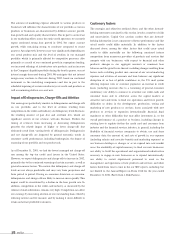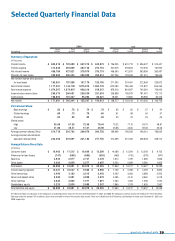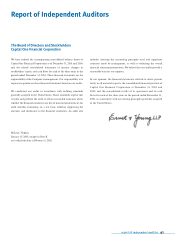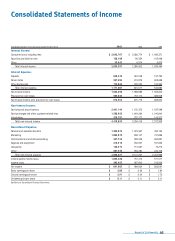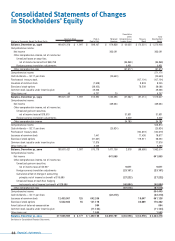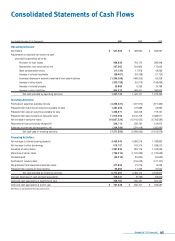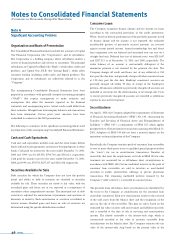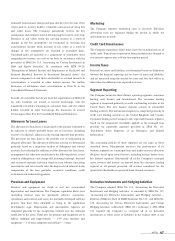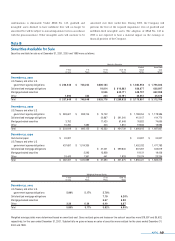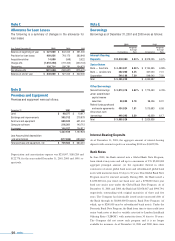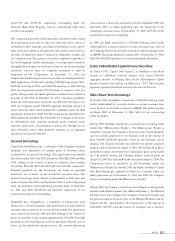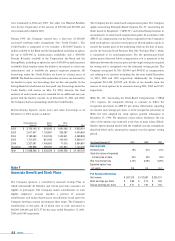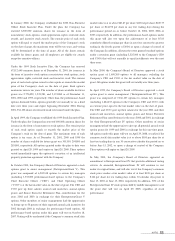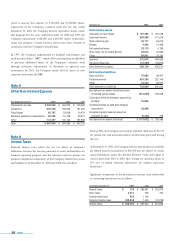Capital One 2001 Annual Report Download - page 48
Download and view the complete annual report
Please find page 48 of the 2001 Capital One annual report below. You can navigate through the pages in the report by either clicking on the pages listed below, or by using the keyword search tool below to find specific information within the annual report.
Note A
Significant Accounting Policies
Organization and Basis of Presentation
The Consolidated Financial Statements include the accounts of Capital
One Financial Corporation (the “Corporation”) and its subsidiaries.
The Corporation is a holding company whose subsidiaries market a
variety of financial products and services to consumers. The principal
subsidiaries are Capital One Bank (the “Bank”), which offers credit card
products, and Capital One, F.S.B. (the “Savings Bank”), which offers
consumer lending (including credit cards) and deposit products. The
Corporation and its subsidiaries are collectively referred to as the
“Company.”
The accompanying Consolidated Financial Statements have been
prepared in accordance with generally accepted accounting principles
(“GAAP”) that require management to make estimates and
assumptions that affect the amounts reported in the financial
statements and accompanying notes. Actual results could differ from
these estimates. All significant intercompany balances and transactions
have been eliminated. Certain prior years' amounts have been
reclassified to conform to the 2001 presentation.
The following is a summary of the significant accounting policies used
in preparation of the accompanying Consolidated Financial Statements.
Cash and Cash Equivalents
Cash and cash equivalents includes cash and due from banks, federal
funds sold and resale agreements and interest-bearing deposits at other
banks. Cash paid for interest for the years ended December 31, 2001,
2000 and 1999, was $1,105,505, $794,764 and $516,114, respectively.
Cash paid for income taxes for the years ended December 31, 2001,
2000 and 1999, was $70,754, $237,217 and $216,438, respectively.
Securities Available for Sale
Debt securities for which the Company does not have the positive
intent and ability to hold to maturity are classified as securities
available for sale. These securities are stated at fair value, with the
unrealized gains and losses, net of tax, reported as a component of
cumulative other comprehensive income. The amortized cost of debt
securities is adjusted for amortization of premiums and accretion of
discounts to maturity. Such amortization or accretion is included in
interest income. Realized gains and losses on sales of securities are
determined using the specific identification method.
Consumer Loans
The Company recognizes finance charges and fee income on loans
according to the contractual provisions of the credit agreements.
When, based on historic performance of the portfolio, payment in full
of finance charge and fee income is not expected, the estimated
uncollectible portion of previously accrued amounts are reversed
against current period income. Annual membership fees and direct
loan origination costs are deferred and amortized over one year on a
straight-line basis. Deferred fees (net of deferred costs) were $291,647
and $237,513 as of December 31, 2001 and 2000, respectively. The
entire balance of an account is contractually delinquent if the
minimum payment is not received by the payment due date. The
Company charges off credit card loans (net of any collateral) at 180
days past the due date, and generally charges off other consumer loans
at 120 days past the due date. Bankrupt consumers’ accounts are
generally charged off within 30 days of receipt of the bankruptcy
petition. All amounts collected on previously charged-off accounts are
included in recoveries for the determination of net charge-offs. Costs
to recover previously charged-off accounts are recorded as collections
expense in non-interest expenses.
Securitizations
On April 1, 2001, the Company adopted the requirements of Statement
of Financial Accounting Standards (“SFAS”) No. 140, “Accounting for
Tr ansfers and Servicing of Financial Assets and Extinguishment of
Liabilities,” (“SFAS 140”), a replacement of SFAS 125, which applies
prospectively to all securitization transactions occurring after March 31,
2001. Adoption of SFAS 140 did not have a material impact on the
operations or financial position of the Company.
Periodically, the Company transfers pools of consumer loan receivables
to one or more third-party trusts or qualified special purpose entities
(the “trusts”) for use in securitization transactions. Transfers of
receivables that meet the requirements set forth in SFAS 140 for sales
treatment are accounted for as off-balance sheet securitizations in
accordance with SFAS 140. Certain undivided interests in the pool of
consumer loan receivables are sold to investors as asset-backed
securities in public underwritten offerings or private placement
transactions. The remaining undivided interests retained by the
Company (“seller's interest”) is recorded in consumer loans.
The proceeds from off-balance sheet securitizations are distributed by
the trusts to the Company as consideration for the consumer loan
receivables transferred. Each new securitization results in the removal
of the sold assets from the balance sheet and the recognition of the
gain on the sale of the receivables. This gain on sale is based on the
estimated fair value of assets sold and retained and liabilities incurred,
and is recorded at the time of sale in servicing and securitizations
income. The related receivable is the interest-only strip, which is
concurrently recorded at fair value in accounts receivable from
securitizations on the balance sheet. The Company estimates the fair
value of the interest-only strip based on the present value of the
46 notes
Notes to Consolidated Financial Statements
(Currencies in Thousands, Except Per Share Data)




